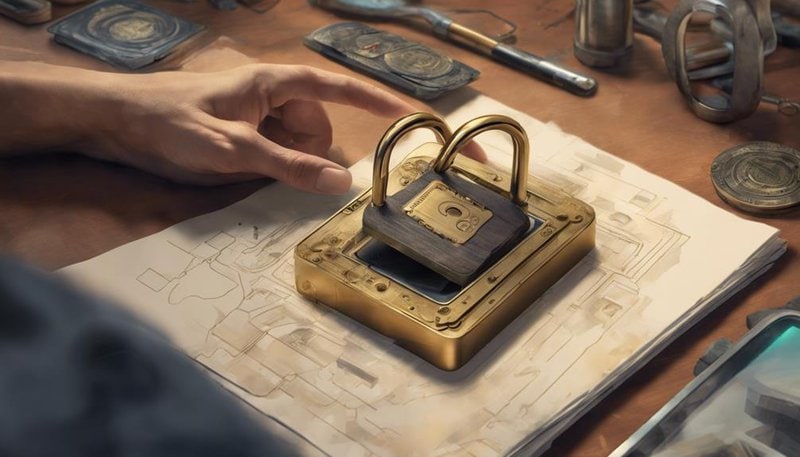How to Tokenize Real-World Assets as NFTs

Tokenizing real-world assets as non-fungible tokens (NFTs) has gained significant interest in recent years. This process involves representing ownership of physical assets, such as real estate, art, or collectibles, on a blockchain through unique digital tokens. By converting tangible assets into digital tokens, individuals can establish ownership, transfer assets more efficiently, and access liquidity through fractional ownership. Overall, the tokenization of real-world assets offers a new way to digitize and democratize ownership of traditionally illiquid assets.
Tokenization platforms and marketplaces have emerged to facilitate the creation, issuance, and trading of asset-backed NFTs. These platforms provide tools for asset representation, smart contract development, and trading functionalities. Investors and collectors can participate in fractional ownership, trade assets globally, and access a wider range of investment opportunities. The transparency, security, and programmability of blockchain technology underpin the tokenization process, ensuring the integrity and authenticity of asset-backed NFTs.
As the NFT space continues to evolve, regulations, standards, and interoperability between different blockchain networks will play a crucial role in shaping the tokenization landscape. Industry collaborations, regulatory frameworks, and technological advancements will further drive the adoption and integration of real-world assets into the digital economy through NFTs. Overall, tokenizing real-world assets as NFTs opens up new possibilities for asset ownership, trading, and investment in a decentralized and scalable manner.
Understanding NFTs and Blockchain Basics
Embrace the essence of NFTs and blockchain by delving into the fundamental concepts that underpin this revolutionary technology. Understanding NFT valuation in secondary markets is crucial in comprehending the true potential of tokenized assets. The value of an NFT isn't only in its uniqueness but also in the demand it garners within these secondary markets. Token transferability, enabled by smart contracts, plays a pivotal role in the fluidity of NFT transactions. These smart contracts ensure that ownership rights are securely transferred, providing a level of trust and efficiency previously unseen in traditional asset transfers.
When navigating the realm of NFTs and blockchain, consider the dynamic nature of valuations and the intricate web of secondary market interactions. Appreciating the nuances of token transferability through smart contracts will empower you to harness the full capabilities of this technology. Remember, in serving others through tokenizing real-world assets, a deep understanding of NFT valuation and the mechanisms that drive secondary markets is key to unlocking the true potential of this transformative innovation.
Identifying Suitable Real-World Assets
As you embark on the journey of identifying suitable real-world assets for tokenization as NFTs, consider the meticulous criteria for asset selection and the crucial legal ownership considerations.
These fundamental aspects will serve as your guiding stars in navigating the intricate landscape of transforming tangible assets into digital tokens.
Asset Selection Criteria
Selecting real-world assets suitable for tokenization as NFTs requires a discerning approach that considers not just the tangible value but also the potential for digital representation. When choosing assets, focus on their uniqueness, demand, and ease of divisibility for fractional ownership. Consider assets with strong provenance and legal clarity to ensure authenticity and market acceptance. Additionally, evaluate the asset's market liquidity and the feasibility of integrating it into blockchain networks. Asset valuation and custodial solutions are crucial factors to weigh during the selection process. By carefully assessing these criteria, you can identify assets that hold value both in the physical world and the digital realm, paving the way for successful tokenization.
| Criteria | Description | Importance |
|---|---|---|
| Uniqueness | Rarity and distinctiveness of the asset | High |
| Legal Clarity | Clear ownership rights and authenticity | High |
| Market Liquidity | Ability to buy/sell without affecting price | Medium |
Legal Ownership Considerations
Consider the legal ownership implications when identifying real-world assets suitable for tokenization as NFTs. To ensure a smooth tokenization process and protect all parties involved, here are some essential considerations:
- Ownership documentation: Clear and verifiable documentation proving ownership of the asset is crucial to establish legal rights in the digital realm.
- Asset valuation: Accurate valuation of the real-world asset is necessary to determine the value of the NFT accurately.
- Legal compliance: Ensure that the tokenization process complies with relevant laws and regulations to avoid any legal issues.
- Smart contract security: Implement robust smart contracts to secure ownership rights and automate transactions reliably.
Choosing the Right Tokenization Platform

As you embark on the journey of selecting the ideal tokenization platform, consider the essential factors:
- Platform security features
- The tokenization process overview
- Adherence to compliance and regulations
Ensuring the security of your assets, understanding the tokenization process intricacies, and complying with legal frameworks are pivotal in making a well-informed decision. Embrace these considerations as guiding beacons on your path to tokenizing real-world assets as NFTs.
Platform Security Features
To ensure the utmost security for your tokenized real-world assets, prioritize scrutinizing the platform's robust security features. Here are four essential security measures to consider when choosing a tokenization platform:
- Multi-layered Authentication: Opt for platforms that offer multi-factor authentication to prevent unauthorized access.
- Encryption Protocols: Choose platforms that utilize advanced encryption methods to safeguard sensitive data.
- Regular Audits: Platforms conducting frequent security audits ensure ongoing compliance and protection.
- Emergency Response Plan: Look for platforms with a well-defined emergency response plan to address potential security breaches promptly.
Tokenization Process Overview
Selecting the ideal tokenization platform for your assets demands a meticulous evaluation of its security features, usability, and scalability. Tokenization benefits, such as increased liquidity and fractional ownership, present exciting market opportunities that can transform traditional asset ownership.
A robust platform should offer comprehensive security measures to safeguard your assets and transactions. Consider platforms with user-friendly interfaces and seamless token management functionalities to streamline the tokenization process. Scalability is crucial to accommodate the potential growth of your asset portfolio and market demand.
Compliance and Regulations
Embarking on the journey to find the right tokenization platform in the realm of compliance and regulations demands a judicious assessment of how well it aligns with the legal frameworks governing tokenized assets. Here are key considerations to guide you on this path:
- Regulatory Challenges: Look for a platform that stays abreast of changing regulations to ensure your tokenized assets remain compliant.
- Compliance Complexities: Seek a platform that offers robust compliance tools to navigate the intricate web of regulatory requirements seamlessly.
- Transparency and Accountability: Choose a platform that prioritizes transparency in its operations and can be held accountable for compliance.
- Legal Support: Opt for a platform that provides access to legal expertise to address any compliance issues promptly and effectively.
Legal Considerations and Compliance

Navigating the legal landscape and ensuring compliance are paramount when tokenizing real-world assets as NFTs. It's crucial to consider tax implications, regulatory compliance, custodial responsibilities, and investor protection. The intersection of traditional legal frameworks and cutting-edge technology in the realm of NFTs requires meticulous attention to detail.
When delving into the legal aspects of tokenizing real-world assets, one must address tax implications head-on. Ensuring compliance with tax laws and regulations is essential to avoid any unforeseen liabilities. In addition, understanding the regulatory landscape is vital to steer clear of legal pitfalls that could jeopardize the entire tokenization process.
To provide a clearer perspective, let's delve into a structured insight:
| Legal Considerations | Compliance | Importance |
|---|---|---|
| Tax Implications | Regulatory Compliance | Ensuring Compliance |
| Custodial Responsibilities | Investor Protection | Risk Mitigation |
| Legal Framework Alignment | Transparency | Trust Building |
Minting Your Real-World Asset as an NFT
As you embark on the journey of tokenizing your real-world asset as an NFT, the pivotal step lies in minting the asset onto the blockchain with precision and foresight. Here are four essential steps to guide you through this transformative process:
- Understand Tokenization Benefits, Risks: Before minting your real-world asset as an NFT, delve into the advantages and risks associated with tokenization. Educate yourself on the potential benefits like increased liquidity and fractional ownership, while also being mindful of risks such as regulatory uncertainties and market volatility.
- Research NFT Market Value Trends: Explore the current trends in the NFT market to gauge the potential value of your tokenized asset. Stay informed about market fluctuations, popular categories, and collector preferences to make informed decisions during the minting process.
- Choose a Reliable NFT Minting Platform: Select a reputable platform that aligns with your tokenization goals. Ensure the platform offers secure minting processes, transparent fees, and a user-friendly interface for minting your real-world asset seamlessly.
- Define Token Attributes and Supply: Clearly outline the unique attributes of your NFT, including metadata, scarcity, and any additional features that enhance its value. Determine the token supply to establish exclusivity and scarcity, contributing to the desirability of your tokenized asset.
Establishing Ownership Rights and Proof

To solidify your claim over the tokenized real-world asset, focus on establishing irrefutable ownership rights and proof. Proof of ownership is paramount in the world of NFTs, where authenticity and legitimacy hold significant value. When embarking on this journey, ensure that the verification process is meticulous and thorough, leaving no room for doubt or dispute.
Begin by gathering all relevant documentation that attests to your ownership of the real-world asset. This could include certificates, contracts, or any legal paperwork that solidifies your position as the rightful owner. Digitize these documents for easy access and verification during the tokenization process.
Additionally, consider leveraging blockchain technology to create an immutable record of ownership. By anchoring your ownership rights to a blockchain, you establish a transparent and tamper-proof trail of ownership that can be easily verified by interested parties.
Marketing and Selling Your NFT
Establishing solid ownership rights and proof sets the stage for effectively marketing and selling your NFT in the vibrant digital marketplace. To ensure success in marketing and selling your NFT, here are four essential strategies to consider:
- NFT Marketing Strategies: Develop a comprehensive marketing plan that leverages social media platforms, online communities, and influencers to reach a wider audience. Engage with potential buyers through interactive content and behind-the-scenes insights to create excitement around your NFT.
- Sales Tactics: Implement strategic sales tactics such as limited-time offers, exclusive drops, and collaborations with other creators or brands to drive demand for your NFT. Create a sense of urgency and exclusivity to encourage potential buyers to make a purchase.
- Digital Asset Valuation: Understand the value of your digital asset by considering factors such as scarcity, uniqueness, and demand. Conduct thorough research on similar NFTs in the market to set a competitive price that reflects the true worth of your creation.
- Pricing Strategies: Experiment with different pricing strategies such as auctions, fixed prices, or Dutch auctions to find the most effective approach for selling your NFT. Monitor market trends and adjust your pricing strategy accordingly to optimize sales and maximize profits.
Ensuring Security and Authentication

Ensuring the security and authentication of your NFT is paramount in safeguarding its value and maintaining trust within the digital marketplace. To protect your digital assets, robust security measures and authentication protocols must be implemented. By fortifying the defenses around your NFT, you not only shield it from potential threats but also enhance its credibility and desirability.
Here is a table outlining essential security measures and authentication protocols to consider when safeguarding your NFT:
| Security Measures | Authentication Protocols |
|---|---|
| Encryption technologies | Multi-factor authentication |
| Secure storage solutions | Biometric verification |
| Regular security audits | Digital signatures |
| Firewalls and monitoring systems | Access control mechanisms |
| Immutable blockchain technology | Token-based authentication |
Frequently Asked Questions
Can I Tokenize Multiple Real-World Assets as a Single Nft?
You can tokenize multiple real-world assets as a single NFT through asset bundling, allowing fractional ownership. Consider legal implications and tax considerations to ensure compliance. This innovative approach merges convenience and regulatory diligence seamlessly.
How Do I Ensure the Authenticity and Provenance of the Real-World Asset When Tokenizing It as an Nft?
To ensure provenance and authenticity verification of a real-world asset when tokenizing it as an NFT, employ trusted third-party verification services. They add credibility and transparency, enhancing the asset's value and trustworthiness in the digital realm.
What Happens if the Physical Real-World Asset Is Damaged or Destroyed After It Has Been Tokenized as an Nft?
If the real-world asset is damaged or destroyed after tokenization, insurance coverage and legal implications become crucial. Explore reimbursement options and navigate the compensation process diligently to protect your investment and rights.
Can I Transfer Ownership of the NFT Representing the Real-World Asset Without Physically Transferring the Asset Itself?
To transfer ownership of the NFT representing the real-world asset without physically transferring it, you can rely on smart contract automation. This process ensures legal implications are met through a verification process, streamlining transactions and securing asset rights.
Are There Any Limitations or Restrictions on Where I Can Sell or Trade My NFT Representing a Real-World Asset?
When selling or trading your NFT representing a real-world asset, consider legal implications and ensure ownership rights. Marketplaces offer liquidity opportunities, but be mindful of any restrictions that may limit where you can transact.








